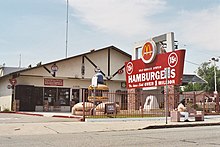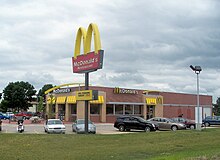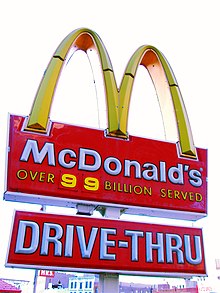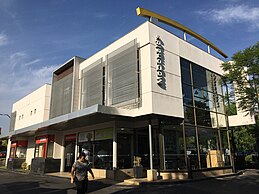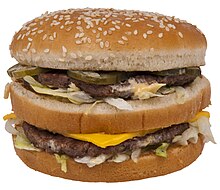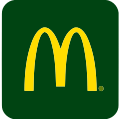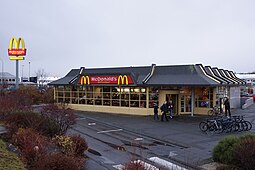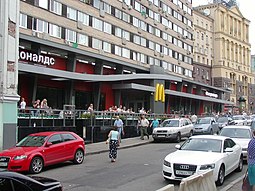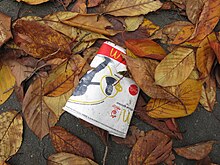McDonald's
McDonald's is an American fast food restaurant franchise headquartered in Chicago, Illinois. Its main products are hamburgers, French fries, breakfast menus, and refreshments. There is also an offer available of milkshakes, ice creams, desserts and, recently, fruit or vegetable salads (as well as other exclusive products depending on the country). It serves approximately 68 million customers per day, in more than 36,000 establishments from 118 territories and countries around the world. The chain employed 1.7 million people in 2014. On the other hand, in most restaurants, different play areas for children have been included.
In 1940, brothers Dick and Mac McDonald decided to start the company and introduced fast food eight years later. His qualitative leap was in 1955 with the first successful franchise, taken over by executive Ray Kroc (who would later try to take control of the company), after a few attempts without much ambition by the McDonald brothers. When the same did not work, they accepted that Kroc was in charge of those franchises, while they only received royalties.
Soon after, its growth and expansion was exponential; Its global presence even led the British publication The Economist to create the Big Mac index, which consisted of comparing the price of a hamburger (the Big Mac, one of the chain's best-known products). in all the countries where they sold it. In this way, it was possible to establish a common parameter for the costs of living in each country, as well as to know if the current currencies were overvalued with respect to the US dollar.
History
Beginnings
On May 15, 1940, Dick and Mac McDonald opened the first McDonald's restaurant on Route 66 in San Bernardino, California. The menu consisted of 20 items, primarily barbecued meat, and was then called McDonald's Famous Barbecue.
In 1948, (with most of the profit coming from hamburgers), the brothers closed the restaurant for several months to create and implement an innovative quick-service system (a kind of set-up in series for hamburgers). Because of this, the carhops lost their jobs. When the restaurant reopened under the name McDonald's Famous Hamburgers, selling only hamburgers, shakes and fries, it became a resounding success.
1950s
In 1953, the McDonald brothers began franchising their restaurants; Neil Fox opened the first franchise and the second restaurant opened in Phoenix, Arizona. It was the first to use the logo based on the Golden Arches, its name being shortened to McDonald's. The original mascot of the chain was a man with a chef's hat on top. of a hamburger-shaped head. His name was "Speedee".
In that year, the original restaurant was rebuilt based on that style. However, the third (opened in 1953 in Downey (California) at the corner of Florence Lakewood Avenue), is still the oldest in operation.
In 1954, Ray Kroc, manufacturer and seller of milkshake machines, decided to visit that restaurant, which ended up placing him an order for 8, when rarely more than one was ordered per order. Upon arrival, he was fascinated by the cleanliness and speed of the service. So, he decided to join this company after seeing the restaurant in operation.
Kroc proposed to the McDonald brothers, who were already selling franchises, the sale of the original location of the company (California and Arizona), being himself the first franchise. Kroc worked hard to sell the McDonald's brand. He even tried (unsuccessfully) to convince Walt Disney to open a McDonald's in Disneyland, which was about to open.
In 1955, Kroc hires Harry J. Sonneborn as McDonald's CFO. Sonneborn would become a great social icon until he resigned in 1967. That same year (March 2), Kroc founded McDonald & # 39;s Systems, Inc, a structure legalized through franchises. The company generally refers to that date as the "beginning" of the company (although he was already fifteen years old). Although the main idea is due to the McDonald brothers, Ray Kroc was given greater value as founder.
1960s
Starting in 1960, it sought to market the image that McDonald's hamburgers were aimed at children and their families. Actor Willard Scott is hired to play McDonald's's new mascot (the clown Ronald McDonald) in the first three television commercials. Ronald McDonald was widely circulated, but it was later decided that Scott was not suitable, so it was decided to develop a cast of characters living in McDonaldland.
In 1960 the name was changed to McDonald's Corporation. The McDonald brothers agree to sell Kroc the rights to their company for $2.7 million, an amount Kroc raised through various loans from investors (including from Princeton University). Finding this sum extremely high, Kroc decided to cut ties with the McDonald brothers. The agreement allowed the brothers to keep their original restaurant, but through an oversight, they were unable to retain the right to continue their McDonald's' franchise. yes. Its name was changed to "The Big M," but Kroc bankrupted it after building a McDonald's across the street from the original restaurant.. If the brothers had kept the original agreement (it entitled them to 0.5% of the network's annual gross revenue), they and their heirs would have earned more than $100 million today. The current design of the restaurants, with windows and tables inside the restaurant, is introduced that same year.
In 1966 the 500th McDonald's restaurant opens in Toledo, Ohio.
In 1968, the Big Mac (similar to the Big Boy hamburger, the signature restaurant of the same name), and hot apple pie were introduced on the menu. That same year, the 1,000th McDonald's restaurant opened in Des Plaines, Illinois, where the 2,000th restaurant would also open in 1972.
1970s
McDonald's headquarters complex, McDonald's Plaza, is located in Oak Brook, Illinois. It is situated on the site of Paul Butler's former Oak Brook headquarters, after relocating from an office within Chicago's Loop in 1971.
The first McDonald's restaurant in Latin America opened in San José (Costa Rica) in 1970; it was the second location outside the United States, since the first was in the British Columbia (Canada).
Maurice James McDonald died in Riverside, California, on December 11, 1971, at the age of 69.
In 1973 the quarter pounder and the egg McMuffin” were introduced: the first Playland McDonald's playground also arrived >, which opens in Chula Vista (California). A year later, the first Ronald McDonald House opens in Philadelphia, Pennsylvania.
In January 1975, the The Drive-Thru service was incorporated in the city of Sierra Vista (Arizona), so that customers could place their orders without leaving the car. Later, it became known as "McDrive", "Automac" or "McAuto" in some countries, since 1986. In 1979 the Happy Meal children's menu was introduced in the United States, to be later marketed abroad.
1980s
In 1980, McDonald's introduced the McChicken, the first chicken meat sandwich, but it was not successful. After being withdrawn from the menu, it was later reissued. The first Ronald McDonald House outside the United States opens in Toronto, Canada in 1981.
In 1983, McNuggets were added to the menu.
Ray Kroc passed away in San Diego, California, on January 14, 1984, at the age of 81. Beginning with the 1984 Los Angeles Olympic Games, the company became an important sponsor of this event until today.
1990s
In 1990, McDonald's and Nintendo begin a promotional partnership, beginning to sell toys of the company's characters with their Happy Meal, beginning with the video game Super Mario Bros. 3 that same year.
In 1993, the company launched its first restaurant at sea on board the Finnish cruise-ferry MS Silja Europa, which sailed between Helsinki and Stockholm. This same year would also open the McCafé, launched by Ann Brown in Melbourne (Australia).
Beginning in 1994, McDonald's banned smoking inside its 1,400 restaurants.
In 1995, the company received complaints from franchisees about many franchises granted, so McDonald's began conducting market research before granting new franchises. In addition, in 1996 the menu began to expand, adding options for breakfast hours.
In 1997 the first (and to date the only) McDonald's Kosher was opened in the world outside of Israel, located in the Abasto shopping center in Buenos Aires, in Buenos Aires (Argentina).
Richard James McDonald passed away in Manchester, New Hampshire, on July 14, 1998, at the age of 89.
2000s
In 2002, the chain closed in Bolivia after its failure. That same year, the McCafé chain had expanded to 13 countries worldwide; the first one (in America) had been created in 2001. By 2003 it was the most widespread coffee shop in Australia and New Zealand.
In 2003, McDonald 's began the advertising campaign I'm lovin' it, which was launched in more than 100 countries at the same time.
In 2006, McDonald's and Disney ended their 20-year promotional partnership, in which they sold movie toys and characters from the production company in the Happy Meal. That same year, a promotional partnership with DreamWorks Animation began. Also in 2006, McDonald's introduced its brand "forever young" through the redesign of all its restaurants; the first major one since the 1970s. Its goal was to be more like a coffee shop, similar to Starbucks. The design featured wooden tables, faux leather chairs, and muted colors: red colors replaced with terracotta, yellow changed to gold for a more 'sunny' look; and olive and sage green were also added. To create a warmer look, the restaurants had brick, less plastic and more wood, with modern pendant lights to produce a softer glow. Many restaurants these days offer free Wi-Fi and have flat-screen TVs, some with music.[citation needed]
In 2008, after the increase in meat prices and in order to preserve the company's profit margins, it was decided to keep the prices of its products at the same value, but the ingredients were halved. In 2009, McDonald's and 20th Century Fox also began a promotional partnership, beginning to sell toys of the producer's characters with their Happy Meal , beginning with the film Ice Age 3/Ice Age: Rise of the Dinosaurs that same year.
2010s
In 2010, Subway surpassed McDonald's as the largest restaurant chain in the history of a single brand and the largest restaurant operator globally. McDonald's then had 32,737 restaurants worldwide in September 2009, while Subway had 33,749 at the end of 2010.
As of December 2010, McDonald's had 1,100 outlets in China. The company announced that 2011 revenue reached an all-time book high of $27 billion, which 2,400 restaurants had upgraded and 1,300 had opened worldwide.[citation needed]
In 2012, McDonald's opened its first vegetarian fast food outlet in India, expanding its customer base to Hindus, Muslims and all those who cannot or do not want to eat meat of beef, pork or cheese. For the London 2012 Olympic Games, McDonald's built the largest of its restaurants with a total of 1,500 seats, but it was only active for 6 weeks until its dismantling.
In 2014, McDonald's launched a self-service system in the United States, which consists of placing orders in a personalized way through touch screens. This format called & #34;experience of the future" It started operating internationally in 2015 and in the following years it has expanded to Europe, Asia and Latin America.
In 2015, McDonald's planned to close 184 restaurants in the United States, but planned to open 59 more. This was the first time McDonald's had a decline net in the number of restaurants in the United States since 1970.[citation needed]
In 2016, a new design for both the exterior and interior stores was launched, presenting a more elegant and intimate environment for consumers, added to the modernization through self-service digital kiosks. The facades became dark gray with white, red and yellow decorations.
In 2018, McDonald's returned to distributing toys from Disney movies and their derivatives, initially in the United States and later worldwide.
2020s
Starting in 2020, McDonald's collaborates with different musical celebrities that include a themed menu, such as Travis Scott, Mariah Carey, BTS, Sebastián Yatra and Cardi B, among others.
In 2022, the chain announced its closure in Russia, due to the Russian invasion of Ukraine in 2022. At the end of the same year, McDonald's opened its first robotic and automated restaurant in the state of Texas, United States.
Features
Format
Most McDonald's restaurants offer both counter service and McAuto, with seating indoors and sometimes outdoors. The Drive-Thru, Auto-Mac, McDrive or McAuto (as it is known in some countries) often have separate booths for ordering, paying, and picking up products. In some countries the "McAuto" near highways does not offer counter or table service. On the contrary, places with a high population density often do not have it.
There are also themed restaurants, such as the "Rock-and-roll McDonald" (from 1950) or the restaurant McMovie, in Porto Alegre, Brazil. [citation needed] There are some places around the world with curious and striking designs, such as a Happy Meal, a UFO or an airplane among others. [citation needed] In 1986, a restaurant inside a ship was opened in Vancouver (Canada), which operated only during the Vancouver International Exposition of that year and is currently Abandoned. A new location was later opened with the same format on the Mississippi River (United States).
Some McDonald's in suburban areas and certain cities have large indoor or outdoor patios (such as in Antigua Guatemala), where the restaurant is housed in a period mansion colonial, called McDonald's Playplace or Playland.
McDonald's trains its franchisees and others at Hamburger University in Oak Brook, Illinois. According to Eric Schlosser's Fast Food Nation (2001), approximately one in ten workers in the United States was, at some point, employed by McDonald's. The book also claims that McDonald's is the largest private operator of playgrounds in the United States, as well as the largest buyer of beef, pork, potatoes, and apples.
Business model
McDonald's Corporation earns income as a property investor, restaurant franchisor and restaurant operator. Approximately 50% of them are owned and operated by the corporation directly. The remainder are operated by third parties through a variety of franchise agreements and joint ventures.
The business model is a little different than most other fast food chains. In addition to the normal franchise fee, resources, and percentage of sales, McDonald's also receives rent, tied in part to sales.
As a condition of many franchise agreements (which vary by contract, age, country, and location), the corporation may own or lease the properties on which McDonald's. In most, the franchisee does not own the premises where his restaurant is located.
McDonald's began using the franchise model in 1955 and has relied on its franchisees to play an important role in the success of the system. Today, about 95% of all restaurants in the United States are franchised to independent franchisees and about 5% are company owned.
Products
Some of the most popular products at McDonald's are:
- Big Mac: is a type of burger that has been sold since 1968. It is composed of "two round pieces of chopped beef (known as pattiesbecause they are ultra-freeze), whose most distinctive feature is the intermediate layer of bread (named club), specially designed to avoid spilling its content while eating. The burger. Big Mac It is world-renowned and often used as a symbol of the culture of American capitalism.
- Fourth pound: is a cheeseburger variant. It is prepared with 125 g. of meat, cheese, mustard, ketchup, onion and pickle in burger bread.
- McChicken: is a chicken sandwich. It consists of a wheat bread roll, empaned chicken (style McNuggets), lettuce in strips and mayonnaise.
- Big tasty is a burger introduced in the United States in 1997 and worldwide on February 16, 2000. It includes a part of meat of a quarter pound, sesame seeds, lettuce, tomato slices, mayonnaise, ketchup, cut onion, two pickles, being cooked on the grill.
- McDLT: It was a burger that had lettuce, tomato, cheese, ketchup and mustard.
- McBaconMcTocineta in Latin America: it is a cheeseburger, slices of panceta, lettuce, tomato, ketchup, mustard and mayonnaise.
- McNuggets chicken: introduced in June 1980, are basically chicken pieces, bounced into a special marinade and then fried. They are also used as part of the menu Happy Meal.
- Happy Meal (Happy Box in Latin America): introduced 1979, it is the name that receives the children's menu McDonald's. It is characterized by including a small gift toy along with food and served in a small box. The menu of a Happy Meal choice between a burger, cheeseburger or McNuggets chicken. It comes with fries and a soda to choose from. In some countries, the menu may include more choice options or special menus with salad or other foods and you can opt for drinks such as milk or juice instead of the usual soda.
- McRib: marketed since 1985, it is a type of sandwich composed of a pork burger, a special barbecue sauce, pepinillos and onion, served in a bread with sesame.
- McMuffin: it was invented in 1973 as a product offered by the franchise at breakfast. It is a burger that instead of meat has a fried egg, York ham and yellow cheese.
- McFlurry: vanilla ice cream with different flavors or cookies like dressing. It was launched in 1997.
In order to cater to local tastes and culinary traditions (often in compliance with local laws or religious beliefs), McDonald's offers regionalized versions of its menu within different countries. As a result, products found in one country or region cannot be found in others. This is the case in India, where sandwiches are made with only vegetables or lamb, since in this country the cow is considered a sacred animal.
McCafé
McCafé is a cafeteria in the style of McDonald's restaurants. It is a concept created in Australia (colloquially known as "maccas"), starting in 1993 in Melbourne. After upgrading to the new McCafé look, some Australian stores have seen up to a 60% increase in sales. At the end of 2003 there were more than 600 McCafes around the world.[citation needed]
Visual identity
Logo
The McDonald's logo (the golden arches) was created in 1960 by Jim Schindler, then head of design engineering for McDonald's. It is based on two golden arches crossed by a line (representing the roof) that was higher at the front than at the back. It was based on the façade of the first McDonald's restaurant designed by architect Stanley Meston in Phoenix, joining the two arches into an "M". In 1968, the line was removed from the gold arches and the font for the text was changed, also showing the word McDonald's within the arches. In the United States since 1975 until 2006, the name written in white is added in a red box.
In Europe, the corporate image was changed by including the logo in a dark green box, which turned out to be a marketing success.[citation needed] In Canada, since 2010, has kept the current version but with the red leaf that appears on its national flag.
Marketing
McDonald's has maintained an extensive advertising campaign for decades. In addition to the usual media (television, radio, and newspapers), the company makes significant use of billboards or signage and sponsors sporting events ranging from Little League Baseball to the Soccer World Cup or the Olympic Games. However, television has always played a central role in the company's advertising strategy.
To date, McDonald 's has used 23 advertising campaigns in the United States, as well as many others in various countries and regions.
Advertising campaigns have also been aimed at children, where the company's flagship character, the clown Ronald McDonald, has been the protagonist along with other characters. The character has also been used to be present at public events, charity events, and children's shows organized by the restaurant chain.[citation needed]
From the 1980s to the early 2000s, extras were used for TV commercials and props for children, who were residents of McDonaldland. Among them were the purple monster Grimace, the bird Birdie, and the hamburger thief Hamburglar, among other characters. By the 2010s, Happy is created, a "real" representation 3. 4; of the Happy Meal to promote the product itself.[citation needed]
McDonald's around the world (date of the first restaurant in the country)
McDonald's in Latin America
In 1967, Puerto Rico became the first Latin American state to receive the McDonald's franchise and is, outside the United States, the second after Canada.
In 1970, a restaurant of the chain was installed in Costa Rica (the first in Central America), being the third country outside the United States. In 1971, the first branches were opened in Panama and Guatemala. A year later in El Salvador and Nicaragua, a country that the company left in 1980 to restart its operations on June 11, 1998. Finally, it later appeared in Honduras.
On February 13, 1979, the first McDonald's was inaugurated in Brazil, in the city of Rio de Janeiro. The unit, located on Hilário de Gouveia street, in Copacabana, is still in operation.
In Venezuela, the first McDonald's was inaugurated on August 31, 1985 in the El Rosal urbanization in Caracas, currently closed since February 28, 2013, after the rental contract for the restaurant was not renewed. land where it was established in 1985.
In Mexico he arrived on October 29, 1986 in the Pedregal area of Mexico City. By 2015, it had more than 420 restaurants, 500 dessert kiosks and more than 32 McCafé units. Since then, some stores have closed in the country due to readjustments or low sales.
In 1986, he arrived in Argentina on November 24, opening his first store on Cabildo Avenue, in Buenos Aires.
In Chile it opened on November 19, 1990 on Presidente Kennedy Avenue in Santiago.
On November 18, 1991, he opened his first restaurant in Uruguay at Montevideo Shopping. The first McDonald's in Colombia was inaugurated on July 14, 1995 at the Shopping Andino de Bogotá, while in Peru it was on October 18, 1996 on Javier Prado Este and Guardia Civil avenues in Lima, and in Paraguay on November 21 of the same year on Aviadores del Chaco avenue (Asunción). The first McDonald's in Ecuador was inaugurated on October 9, 1997 in the Iñaquito shopping center in Quito. However, in the 1970s, another McDonald' 39;s parallel to the American one (whose food supply was not the same as that of the multinational), creating a dispute between the two companies in 1997. It ended up being resolved favorably for McDonald's Ecuadorian since he had paid the rights to register the trademark, as established by law.
The only Latin American country where there is currently no McDonald's is Bolivia where the chain had a presence since November 21, 1997 when it opened its first location in Santa Cruz de la Sierra until November 30, 2002, year in which he announced the removal of the franchise from the country due to low sales.
On August 15, 2012, a commercial court in San Salvador ordered the seizure of its 36 commercial emblems, as well as the payment of a fine of 23.9 million dollars to the businessman, due to legal disputes with businessman Roberto Bukele.
In January 2013, the company's tagline changes to its American counterpart, going from "I love it" to "I'm Lovin' it." It”, its international version in English.[citation needed]
McDonald's in other countries
The first McDonald's opened in a country outside the United States was in Richmond, British Columbia, Canada.
In December 1970, a branch was opened in San José, Costa Rica, being the first McDonald's location in Latin America.
In July 1971, a branch was opened in the Ginza district of Tokyo, Japan, making it the first McDonald's in Asia. On August 21, its first branch in Europe was opened, being located in Zaandam, near Amsterdam, in the Netherlands. In December, its first restaurant in Germany was also opened, in the city of Munich. It was the first McDonald's to sell alcohol (specifically beer), followed by other European countries in the 1970s.[citation needed] A branch in Yagoona (a suburb of Sydney) was also opened in December, being the first restaurant in Australia.
In 1972, McDonald's opens its 2,000th restaurant in Des Plaines, Illinois.
On October 12, 1974, the first McDonald's opens in the United Kingdom, located in Woolwich, south-east London, numbering 3,000.
In 1976, the first restaurant in New Zealand was opened in Porirua. In 1978, the 5,000th restaurant was opened in Kanagawa, Japan. In 1979, the first restaurant in France was opened, in the city of Strasbourg. In 1980, the 6,000th restaurant was opened in the capital of Germany.
The first McDonald's opens in Spain on March 9, 1981, on Gran Vía in Madrid.
In 1986, McDonald's opens its first franchise in Italy, located in Rome. To match the historical landscape near the Spanish Steps, new standards are set for interior decoration.
In 1988, its first restaurants were opened in communist countries. In Györ, Hungary, Belgrade and in the then-existing Yugoslavia. On January 31, 1990, the first McDonald's in Russia opens in Moscow. This was for some time the most largest in the world (currently the largest is in Beijing).
On April 23, 1992, the largest restaurant in the world to date opens in Beijing, the capital of China, with a capacity of more than 700 seats. In 1992 the first one also opened in Casablanca, Morocco. On December 8, 1993, McDonald's opens its golden arches in Saudi Arabia for the first time.
In 1996, the first branch was opened in India. This same year, the first McDonald's was opened in Belarus, which became the hundredth country to receive a franchise. At the opening ceremony, the Belarusian army was accused of aggression against attendees who wanted to enter the restaurant in Minsk.
On February 8, 2014, McDonald's opened its first restaurant in Vietnam in Ho Chi Minh City.
Restaurants
Abandoned Markets
- Barbados: closed for low sales; it worked from 25 August 1989 until 13 December 1990.
- Bermuda: closed by a government rule; it worked from 10 November 1985 to 9 March 1995.
- Bolivia: closed for low sales; it worked from 21 November 1997 until 30 November 2002.
- Jamaica: closed due to government problems and the decline in sales; it worked from 15 April 1995 until 14 October 2005.
- Iceland: closed during the Icelandic financial crisis of 2008-2011, according to the Icelandic franchise, for the prohibitive costs of importing foreign foods required by the marketing system McDonald's. The selling points were renamed by the food chain Metro, offering similar services and menus with national ingredients; it worked from 9 September 1993 to 30 October 2009.
- North Macedonia: closed due to the dispute over the contract and contractual obligations with the owner of the Sveto Janevski franchise; it worked from 6 September 1997 until 15 May 2013.
- Montenegro: closed for lack of settlement, operated from 6 September 1996 to 2007.
- San Marino: closed the only establishment in the country due to the proximity of Italian restaurants that meant a drop in sales at the restaurant; it worked from July 6, 1999 until July 6, 2019.
- Russia: temporarily closed for the invasion to Ukraine, but on May 16, 2022 permanently announced its closure of the Russian market, pending the sale of its restaurants; it worked from January 31, 1990 until March 8, 2022, now back to the market, although managed and managed by Russian gastronomic entrepreneurs, who on Sunday, June 12, 2022, reopened their premises throughout the country with another name
Charity
McHappy Day
McHappy Day (McDía Feliz) is an annual event at McDonald's, in which a percentage of that day's sales will go to the charity. Fundraising generally goes to the Ronald McDonald Foundation. In Latin America it is usually celebrated on November 13.
In 2007 it was held in 18 countries: Argentina, Australia, Austria, Brazil, Canada, Finland, France, Guatemala, Hungary, United Kingdom, Ireland, New Zealand, Norway, Sweden, Switzerland, United States, Uruguay and Venezuela.
In 2009, McHappy Day raised $20.4 million.
In 2010 the collection was 20.8 million.[citation needed]
Ronald McDonald Foundation
Ronald McDonald House Charities (RMHC) or Ronald McDonald Children's Foundation is a civil association present worldwide that seeks to create, identify and support programs that directly improve health and the well-being of children.
There are 389 Ronald McDonald Houses in operation in 37 countries. They have more than 305,000 volunteers and employees, which make it possible to help more than 20,000 families a day and 9 million children a year.
Disputes
Fast food has created numerous problems, especially health-related, because it contains a lot of fat. The documentary film Super Size Me (2004), directed and starring Morgan Spurlock, in which he decides to eat only food at McDonald's restaurants for a month whole, reopened the controversy about the nutritional quality of fast food in general and the chain in particular. In addition, some nutritionists believe that fast food can be part of a more diverse balanced diet. It is called junk or garbage food because of the few nutrients it provides the body.
Another controversy has to do with the often precarious working conditions of restaurant workers. In fact, the American writer Douglas Coupland created the term «McJob» (“McJob”), to define a job with low wages, few possibilities of job promotion, requiring little training and where the activity is strongly regulated.
The McLibel case (also known as the McDonald's Restaurants v. Morris and Steel Case) is another example of the criticism it receives: in 1990, activists from a small group known as London Greenpeace (no connection to Greenpeace) distributed pamphlets titled What's wrong with McDonald's?.;s?), criticizing the consequences for the environment, health and work of the company. The corporation wrote to the group demanding that it desist and apologize. When two of the activists refused to do so, they were sued by McDonald's in one of the longest cases in British civil law. McLibel, a documentary about the case, was screened in various countries.
Regarding McDonald's advertising, one of the main criticisms from consumers is that the appearance of the hamburgers they buy does not resemble what they see in the advertisements. To clarify this, in June 2012, McDonald's Canada director of marketing, Hope Bagozzi, posted a video comparing a real hamburger to a real hamburger. specially prepared for the photo shoot. The video shows a "food stylist" putting together a burger in a photo studio, carefully assembling the ingredients so that the camera can capture them correctly from a specific angle. The image is then digitally edited to hide blemishes. Also in the video, the "real" burger is photographed under the same conditions as the "advertised" one and then they are compared. According to Bagozzi, the smaller size of the "real" bread is due to the fact that, when it is stored hot in a cardboard box, it generates steam, causing the bread to lose volume.
McDonald 's Related Events
On July 18, 1984, a man named James Oliver Huberty attacked a McDonald's restaurant with multiple firearms, killing 21 people and injuring 19 others before dying. inside the restaurant, located in San Ysidro, San Diego (California), in what would be called the San Ysidro McDonald's Massacre .
On May 7, 1992, Derek Wood (an employee) and two friends robbed a McDonald's in Sydney River, Nova Scotia, Canada, killing three people and injuring seriously to another. Wood is currently serving a life sentence for his role in the murder. In August of that same year, a citizen named Stella Liebeck received third-degree burns from coffee purchased at McDonald's. She ended up suing the company, in what became known as the "McDonald's coffee" case. On April 28, 1992, seven restaurants were bombed in Taiwan, killing one policeman and injuring four.
On February 16, 2006, a 24-year-old police officer murdered his 23-year-old girlfriend (who was also on the police force) and then committed suicide with his own weapon in a McDonald's in Buenos Aires, Argentina, local located near the National Congress. In that year, a former employee with Asperger's syndrome stabbed his former manager to death during a children's party at the McDonald's he supervised in West Sussex, England; he was sentenced to life imprisonment by Lewes Crown Court.
In 2007, an explosion at the McDonald's network of cafeterias in St. Petersburg, Russia, left at least six people dead, including two children.
In July 2014, gunmen shot at a McDonald's store in the Miraflores district of Lima (Peru), killing a man who was identified as Peruvian businessman Nicola Bonavia Wong; days later, the victim was proven to be a Serbian arms dealer named Frederick Stabrick, who had created a false identity.
In October 2015, 25-year-old Astrid López, who worked as a cashier at a McDonald's in the Pedregal district of Panama, was murdered by assailants who had demanded that the manager on duty and to the cashier the money from the boxes. When the cashier ran out behind her, she was chased by one of the assailants, who hit her on the head.
On November 9, 2015, one of the McDonald's branches located in the municipality of Tlalnepantla (State of Mexico) was closed, after a diner denounced having found the head of a rat in his hamburger. The premises proceeded to an investigation to confirm the event. In addition, the Attorney General's Office reported the case to health institutions. Despite some indications found in the premises, it was ruled out that the animal had appeared in the preparation of the hamburger, so the rat head would have been placed in a premeditated way.
In September 2019, a man was killed and another was injured after an attack on a McDonald's store in the Miguel Hidalgo district of Mexico City.
On December 15 of the same year, two young cleaning workers were electrocuted in a place in the district of Pueblo Libre, in Lima (Peru). The relatives of the victims demanded an in-depth investigation into their deaths, due to the company's accusations of negligence, exploitation, and job insecurity. The company was fined $250,000 for security violations and for failing to report the deaths of the victims. workers on time. Just two months later, in February 2020, another worker was electrocuted at the premises of the Independencia district. it was archived. In November 2020, the definitive closure of the Pueblo Libre location was announced.
In January 2020, in another Lima location in the Lince district, Isaac Hilario, a Peruvian businessman with complaints and accusations of pimping, was murdered. At the time of the attack he was accompanied by three Venezuelan women.
In August 2022, in a New York store, a worker died after being shot by a subject, after an alleged claim for selling him cold food.
Law of the Golden Arches
The law of golden arches was elaborated by Thomas Friedman, a columnist for the New York Times and three-time Pulitzer Prize winner, in his book The Lexus and the Olive Tree. The law was popularized by publicizing the fact that no two countries where McDonald's is located have declared war. Through an imaginative use of the inductive method, one concludes that the countries with this restaurant chain do not go to war on each other.
Contenido relacionado
Mecca-Cola
Pepperoni
Fondue
Polar Companies
Sashimi bōchō
